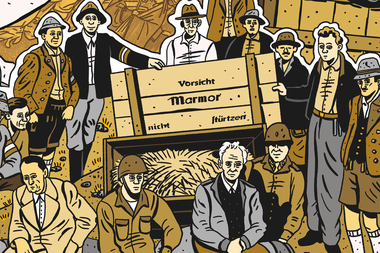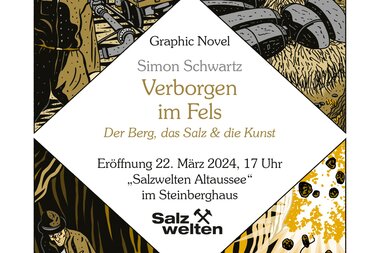Hidden in the Rock. The mountain, the salt & the art Graphic Novel by Simon Schwartz

Graphic Novels Have Stories to Tell
Narratives in images have always provided a unique take on history. The German comic artist Simon Schwartz is a master at this and brings historical events to life. Commissioned by Salzwelten GmbH and Cultural Capital Bad Ischl Salzkammergut 2024, he has managed to capture the eventful history of the Altaussee salt mine from the Stone Age to the Nazi era in a graphic novel. This will be on display in an exhibition at the Steinberghaus from March 22, 2024, which is free to the general public. And, of course, this graphic novel is also available in book form.

Online Purchase
Publication: March 2024
40 pages, hardcover
21 x 29.5 cm, full-color
The book is available in the online shop from March.
Order now
Simon Schwartz: Comic Artist, Author, and Illustrator
Simon Schwartz is one of the most well-known German comic artists. He made his debut in 2009 with "drüben!", a graphic novel about his parents' departure from East Germany. His book "Packeis" received the Max and Moritz Prize in 2012. He designed a 7 x 40-meter frieze for the Stasi Memorial in Erfurt. In 2017 and 2019, he presented solo exhibitions in the German Bundestag. Additionally, this award-winning artist profiles his comics and illustrations in publications such as the Frankfurter Allgemeine Sonntagszeitung and "Die Zeit."
Conversation with Simon Schwartz
Salzwelten: In your work for Salzwelten GmbH and Cultural Capital Bad Ischl Salzkammergut 2024, you delve into the history of salt mining in Altaussee and the dark chapter of Nazi looted art that was hidden in the mines to protect it from bombing raids and was almost destroyed by the Nazis. What do you say to skeptics who believe that such a challenging historical topic cannot be conveyed through a comic?
Schwartz: The term "comic" is not entirely suitable because it implies something humorous. It typically brings to mind childish, funny, and fictional content. My works are graphic novels, which are longer, self-contained, fact-based narratives that can sometimes span two to three hundred pages. They are intended for a more mature audience. The increasing importance of graphic novels is evident, as, for example, in "Rude Girl" by Birgit Weyhe, which was nominated for the Leipzig Book Fair Prize 2023 in the Non-Fiction category, marking the first time a "comic" received such recognition. The landscape has evolved significantly in the last 15 to 20 years. Graphic novels are a form of literature that combines text and images to tell stories incredibly directly. By the way, graphic novels are the only segment in the book market that continues to grow! And to answer your question: Yes, history can be perfectly conveyed through graphic novels!
Salzwelten: How do you approach a project like "Hidden in the Rock"?
Schwartz: In general, I conduct very thorough research for all my projects. When I work on historical topics, as is the case in most instances, it's crucial for me that all data and facts are entirely accurate. In "Hidden in the Rock," everything historical is based on facts, not just in content and text but also in the visuals. In cases like this, I search for historical photographs, as I did here. The staff at Salzwelten and their archives were a significant help, as was the book "World Art Treasures at Risk" by the former Saltworks General Director Emmerich Pöchmüller. However, with contemporary sources, you must always bear in mind that they are "a product of their time," and what they wrote should be approached with caution. For example, when he talks about looted art being stored, he refers to it as "art from abroad." I have always cross-referenced Pöchmüller's statements with other sources, which were essential in my research.
Salzwelten: Did you also visit Altaussee in person?
Schwartz: Of course, I visited Altaussee myself and explored the mountain, the mine, and the tunnels where the art looted by the Nazis was stored. I tried to get a sense of the place, its unique atmosphere, and its unique air. Only then can you immerse readers in the story while remaining historically accurate.
Salzwelten: The story of the rescue of the art treasures was depicted in the Hollywood film "Monuments Men." Have you seen the movie, and if so, what did you think of it?
Schwartz: I did watch the film years ago. However, as you may know, it comes from Hollywood, the dream factory, and, contrary to my graphic novel, it is not historically accurate and was, therefore, not relevant to my project.
Salzwelten: The Waterman character in your Graphic Novel is probably not quite "historical" …
Schwartz: (smiles) Yes... With the character of the mythical Waterman, I created a poetic and fictional narrative framework that helps condense thousands of years of history into a few pages.
Salzwelten: How long did you spend on the research for this project? And how did it go from there?
Schwartz: In total, I spent about four months on the research for this project. When dealing with a story that spans from the Middle Ages to the present day, thorough research takes some time. After that, I began working on the initial texts and illustrations.
Salzwelten: When looking at your works, you can see that they have various styles. How do you go about finding or developing a style for text, images, and a color palette for a story like the one about Nazi looted art?
Schwartz: First and foremost, I strive to keep the text as factual and straightforward as possible, as I mentioned earlier. This also applies, to some extent, to the visuals. However, with images, you can create a more emotional atmosphere, sometimes in contrast to the more factual text. Regarding the color scheme for this project, it was clear to me from the beginning that it should be more monochromatic and not overly colorful, as "Hidden in the Rock" is primarily intended for exhibition in a physical space. Too much color would overwhelm visitors.
Salzwelten: How can one envision the exhibition?
Schwartz: Well, technically, there are two exhibition rooms at the Steinberghaus in Altaussee. The first room tells the millennia-long history of salt mining, while the second room is dedicated to the history of the art treasures. The pages of the graphic novel were printed on large panels and hung in the rooms. Visitors can sit on benches and read the texts at their leisure, as well as view the images. The aim is for them to linger and immerse themselves in the story, just as if they were reading a book…
Salzwelten: Good point: So this graphic novel will also be available as a book …
Schwartz: Yes, "Hidden in the Rock" will also be available in book form.
Salzwelten: Mr. Schwartz, thank you very much for this fascinating conversation! And, of course, for creating the first graphic novel about the Salzkammergut!
The Eventful History of the Altaussee Salt Mine
The Altaussee salt mine has a long and eventful history: Salt has been mined here since 1147. "White Gold" has been a vital source of livelihood for the people in the region for centuries. However, during World War II, the mine was repurposed: From 1943 to 1945, the Nazis concealed valuable looted art in the tunnels. Thousands of paintings, statues, and other art objects, intended for an exhibition in the "Führer Museum" in Linz, were stored inside the Altaussee mine. Faced with imminent defeat, the Nazis decided to destroy all the art treasures in May 1945. Fortunately, a few courageous men from Altaussee saved the artworks... You can read the whole story from the Middle Ages to "Monuments Men" right here.
Exhibition Opening:
Friday, March 22, 2023, 5:00 PM in the Steinberghaus at Salzwelten Altaussee, Lichtersberg 25, 8992 Altaussee
Combo Ticket for €35,--
including
- Admission to Salzwelten Altaussee
- Exhibition of the Graphic Novel "Hidden in the Rock. The Mountain, the Salt & the Art" at the Steinberghaus
- Admission to the exhibition "Wolfgang Gurlitt. Art Dealer and Profiteer in Bad Aussee " at the Kammerhofmuseum in Bad Aussee: This exhibition explores the life and work of Berlin art dealer Wolfgang Gurlitt and his Jewish business partner Lilly Christiansen, who lived in Bad Aussee from 1940 onwards.
- Admission to the exhibition "The Life of Things" at the Altes Marktrichterhaus in Lauffen: This exhibition delves into the systematic looting of art, a phenomenon and a means of legitimizing cultural dominance known since ancient times, through works and installations by contemporary artists.
-
Admission to the exhibition " The Journey of Paintings" at Lentos Linz: The exhibition showcases over 70 artworks collected, stored, looted, forcibly sold, relocated, and saved in the Salzkammergut during World War II. Masterpieces by Goya, Edvard Munch, Lovis Corinth, Giovanni Battista Tiepolo, Tizian, Anthonis van Dyck, Moritz von Schwind, Ferdinand Georg Waldmüller, and many more tell their story of travels and odysseys with numerous stops and storage locations.
Experience more "salty" art!
The European Cultural Capital Bad Ischl Salzkammergut 2024 casts a spotlight on the diversity of historically rooted as well as contemporary art and culture.



